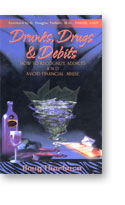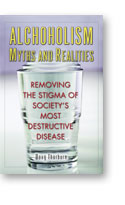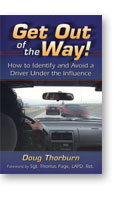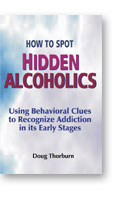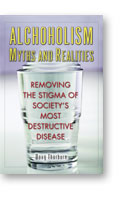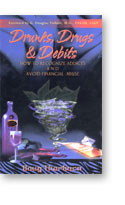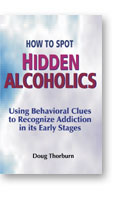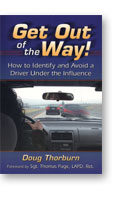 |
|
Issue #69 - March/April/May 2012
|
|
We’re back!
We hope you have enjoyed the first five issues of “TAR Lite” (if you somehow haven’t seen them, here’s the link), which we hope to send weekly. The reviews have so far been very complimentary and even flattering.
We’re pleased to announce that Alcoholism Myths and Realities is now available as an e-book in several formats. How to Spot Hidden Alcoholics will soon be available as an e-book. We’ll keep you posted!
Since the last issue, there’s been a lot of news that can only be understood through the lens of addiction, from out-of-control soldiers and Secret Service agents to premature deaths of celebrities and popular painters to (allegedly) abusive politicians and public school teachers. Please read on, discover and enjoy!
|
|

|
Welcome to the Thorburn Addiction Report in which we interpret the news through the lens of alcohol and other drug addiction. Each month, we bring you several sections, including: 1. Top Story of the month along with runners up, persons under watch, enablers, disenablers and more 2. Review or Public Policy Recommendation of the month 3. Dear Doug in which a recent letter to "Dear Annie" or other "help" column is rewritten, with responses given from the unique perspective that alcohol or other drug addiction best explains the misbehaviors described 4. Alcoholic Myth-of-the-Month 5. Alcoholic Antic-of-the-Month, usually where someone deserves the Darwin Award, but lived. There is something for everyone!
Addiction Report Archives here
© 2012 by Doug Thorburn
|
|
The blog is open to your comments. We’ll be interested in any thoughts you, our loyal readers, may have.
Books Here
|
|

The Afghani Massacre and the Secret Service Scandal: the Common Thread is Alcoholism
Stories of out-of-control American soldiers in Viet Nam drinking and drugging are legion. Soldiers engaging in Viet Nam massacres such as those at My Lai did not, as often inferred, use drugs to “deal with” the nightmare in which they lived. Those who commit murder and especially those leading others in committing atrocities, including wartime massacres, are nearly if not always alcohol or other-drug addicts first. They do not use addictively because they engage in carnage (“anyone who saw such horrors would drink!”); they commit atrocities and cajole others into engaging in them because their addiction requires the capricious wielding of power over others. Murder is one way by which to exercise such power.
Consider the soldiers involved in the Abu Ghraib scandal that broke in 2004, in which detainees were stacked in pyramids after being raped with phosphorescent light sticks and forced to masturbate in groups. Soldiers inside Abu Ghraib describe one of their own “with a strong personality and red flags in his record,” who triggered the group descent into “horrific behavior.” “Strong personality and red flags” is, especially when the phrases are used together, a euphemism for “alcoholic.” This includes the soldier described, Charles Graner, who was also characterized as being able to easily lead weak-willed people to do whatever he wanted. Recall the amphetamine-addicted alcoholic Jim Jones of Jonestown, Guyana, who led 909 men, women and children to commit Flavor Aid suicide, along with nearly every other cult-like leader in history.
Graner joined the marines in 1988 and left the service after the 1st Gulf War. He became a construction worker and then a prison guard at a state penitentiary, where he was reprimanded three times and suspended four times for showing up late or not showing up at all. Graner was never fired, nor was he ever apparently given a choice of job or sobriety, even though alcohol or other-drug addiction is by far the most common explanation (never an excuse) for serial tardiness.
Between 1997 and 2001 Graner’s then-wife got three restraining orders and accused him in court of threatening to kill her and trying to throw her down a stairway. There is nothing in the record to suggest any judge ever offered Graner a choice between prison and sobriety, even though alcoholism is the root cause of domestic violence at least 80-85% of the time.
After Abu Ghraib, fellow soldiers described Graner as “unafraid of confronting the enemy” and a “very charming guy. People tend to follow him, whether it’s the right way or the wrong way.” Graner is a classic in the annals of likely alcoholism: often charming and heroic, seemingly born leaders while intermittently destructive, in this case horrifically so.
On the other hand, risk-taking behaviors, which often appear volatile, can be helpful for human progress, which is one of the grand and perverse paradoxes of alcoholism. Alcoholics in the early stages of their disease frequently take risks the more sober among us would never consider. They often become successful and sometimes famous when those risks pan out (and more quickly lose everything when they don’t). They have an almost universal need to win regardless of cost—and sometimes for the benefit of the rest of us. Ted Turner brought us 24-hour news channels. Rush Limbaugh brought us talk radio. Multitudes of alcoholics innovated in the creative arts, including most of the greatest writers, painters and musicians, from Mozart and Beethoven to John Lennon (the most likely explanation for which is in issue # 31 of my client letter, Wealth Creation Strategies. Ulysses S. Grant helped win the Civil War while he was still a practicing alcoholic. At a military parade in 1863, the man whom contemporaries considered the finest horseman ever to attend West Point was so drunk he fell off his horse.
However, whether by purpose or sheer dumb luck the volatility and downside can destroy those who cross their paths, while addicts can bring themselves down by taking risks appearing as simply awful judgment. Such is the case in two recent seemingly unrelated events: Robert Bales’ alleged murder of 17 innocent Afghanis and the Secret Service scandal in Columbia.
Robert Bales, an Army staff sergeant serving in Afghanistan on his fourth tour of duty, reportedly trained his men carefully, was vigilant on patrols and treated Iraqis and Afghanis with the utmost respect—until he allegedly didn’t. He has been charged with 17 counts of murdering Afghan civilians, in a house-to-house bloodbath beginning around 3 a.m. after a night of “drinking,” which the addictionologist would strongly suspect was addictive in nature.
Robert Bales is a man about whom a friend, stunned over the Afghani massacre, said, “There is no way the guy I knew did this. You don’t go from being a local hero to a monster.” Other friends, who knew and worked with him for years, concurred with similar remarks.
Yet this was not the first time this otherwise heroic and patriotic soldier with a wife and two young children engaged in misbehaviors while drinking. In 2002, Bales set off a fight with a woman’s companion at a casino bar in Tacoma, WA after he grabbed her hand and put it in his crotch. The woman told police Bales had been “drinking heavily.” Prosecutors declined to press charges because “it was a mutual scuffle between two drunk adult males, and it couldn’t be determined who started the fight.” In an apparent separate incident at a bar, Bales was charged with criminal assault for threatening another customer and, after refusing to leave, a security guard. He paid a $300 fine and underwent anger management training to have the charge dismissed. (Studies cited in Drunks, Drugs & Debits suggest there are near zero incidents of anger management “classes” that have resulted in a reduction in the incidence of violent behaviors without treatment for alcoholism.) Bales also was linked to a drunken fight at a bowling alley in 2008. There is no mention of any judge ever giving him a choice between jail time and a program of sobriety as a result of such misbehaviors. And these are only the public cases; for every situation for which police are called, there are often dozens if not hundreds of similar incidents, swept under the rug by well-meaning friends who, after a shove or a missed punch, talk him down. There are no reports of any friends or family members giving him the option of getting sober or losing their emotional and financial support. More importantly, there is no mention of the Army telling him he could no longer drink if he was to be allowed to continue to serve.
Bales reportedly “drank” the night of the massacres. We know from previous episodes he drank addictively; therefore, “drank” in this case is a likely euphemism for “drank heavily” and, therefore, addictively. The description of what Bales remembers suggests an alcoholic blackout: he remembered a few things both before and after the alleged atrocities, but nothing in-between. During a blackout, events don’t enter the brain’s memory banks, leaving nothing to remember, even while he may have appeared stone-cold sober and capable of extraordinarily intricate and demanding tasks. This includes the commission of expertly-applied violence, just as alcoholic surgeons have operated and Boeing 747 pilots have flown during blackouts.
Alcoholism-fueled exercise of capricious power may take form in the commission of acts that appear to others as extraordinarily poor judgment. This includes Secret Service agents engaging prostitutes, thereby compromising the safety of the President before a visit to Cartagena, Columbia for a summit. Poor judgment rooted in alcoholism clearly includes the agent who, after a “wild night of booze,” ended up in an argument with a hooker over her $47 fee, resulting in her leaving his hotel room after the 7 a.m. curfew the hotel implicitly set for overnight “visits.” It also includes a number of other agents who had engaged 11 hookers in all. Most of the agents are married and, therefore, could be easily compromised and susceptible to blackmail. Ronald Kessler, an expert on the Secret Service and author of a book on the agency, said it could have resulted in a potential assassination attempt on the President, not to mention possible breaches of national secrets.
Nearly all law enforcers who act badly do so not because they are fundamentally rotten, but rather because they have the disease of alcohol or other-drug addiction. Since they hold particularly powerful positions in the public trust, more than others they need to be sober. The idea of enforcing sobriety among law enforcers is discussed in greater detail in this month’s “public policy recommendation,” below.
|
|
Runners-up for top story of the month:
Those who have cried, “Guilty until proven innocent!” and would like to form a lynch mob (including Jesse Jackson and Al Sharpton) in the killing of Trayvon Martin by George Zimmerman, who seemingly support Napoleonic “justice” when it suits their ends. BothTrayvon and Zimmerman exhibited behavioral signs of alcohol or other-drug addiction (Trayvon recently in spades—he was described as a “troubled teen,” which is usually a euphemism for “he’s into drugs”—see the article here; Zimmerman in a case of domestic violence, years ago), so this could easily be a case of addict v. addict. However, sober-minded people are much more likely to admit that because we weren’t there, it’s impossible to know what actually occurred with certainty and that justice must be allowed to take its course.
San Francisco Sheriff Ross Mirkarimi, days before his trial on charges of domestic violence, pleading guilty to one misdemeanor count of falsely imprisoning his wife, Eliana Lopez, during an argument on New Year’s Eve. Nearly all domestic violence is committed by alcoholics. Since it was New Year’s Eve (even if it was lunch time), the odds of alcoholism approach 100%. This is especially true when the abuser screams obscenities, tells her she “didn’t deserve to eat” and threatens to take their two-year-old son away from her, after she had simply asked permission to visit her family in Venezuela after his January 8 inauguration. (The list of clues to alcoholism in How to Spot Hidden Alcoholics includes the use of obscenities, but not even I thought of an assertion that one doesn’t deserve to eat and threats to take a spouse’s child, but I digress.) Moreover, Lopez was apparently not the only woman in Mirkarimi’s past who was bruised and tearful; an ex-girlfriend, Christina Flores, made similar allegations. The conviction does not preclude Mirkarimi from keeping his job (and of course his pension), which he had ascended to after winning election to the post only two months before. Whether he is fit for a job that is largely about arresting other alcoholics and preventing them from committing mayhem is now in the hands of the city ethics commission and Board of Supervisors. Mirkarimi was sentenced to three years of probation, 100 hours of community service, 52 weeks of domestic violence classes, a $400 domestic violence fine and parenting or family counseling. Nothing suggests he will be required to wear an ankle bracelet that would continuously test for alcohol in his system or otherwise be coerced into abstinence.
Under watch:
In an early 2009 piece on white collar crime, The Economist magazine mentioned something those who have read my books would predict: “Many [Club Fed and other white collar] prisoners suddenly discover, post-conviction, that they had a drinking problem….” I would add that those who don’t figure this out might benefit from greater introspection. In the spirit of The Economist’s discovery, several recent stories follow for which the evidence of alcoholism is in the alleged crime itself.
Tax preparation service Mo’ Money co-founder and CEO Markey Granberry, who said that customers not receiving completed copies of tax returns or tax refunds was “not his fault” and, further, not a “Mo’ Money, Money Co USA Taxes Problem, this is a systemic problem,” whatever that means (I suspect he’s trying to blame the IRS for his woes). He told reporters, “I don’t have the money.” His wife of 20 years filed for divorce last September after she had him arrested for domestic assault, claims he withdrew $750,000 from a joint account in 2009 and could be hiding assets other than his $1.4 million home in Shelby County, TN, his Lamborghini, Bentley, Lexus, Mercedes and Escalade. (I guess she doesn’t have the money, either.) He’s behind $55,000 in property taxes on various properties listed in his name, with at least four properties slated for tax sale. Living a grandiose and luxurious lifestyle while failing to keep up with financial obligations indicates late-stage alcoholism has begun to take hold. His chief enabler, his wife, took the rocket ship up with the addict’s successes and, now, she’s crashing with him. Unfortunately, Granberry has also adversely affected tens of thousands of innocent people, from customers to landlords—including my wife and me, who rented an office to a franchisee of his, who apparently also was a victim. (By the way, we rented knowing there might be a problem based, more than anything else, on Mo’ Money’s advertisements, which were moronic. The tenant, while skipping out on his lease obligation, at least left the office in good shape.)
LAUSD teacher Mark Berndt who, in the latest in a series of teacher scandals, has been accused of seeking sexual gratification by spoon-feeding his semen to his third-grade students (and yes, for the unbelieving, his DNA matches that of the semen found on a spoon and a small container apparently found in his classroom trash). When I asked the late Fr. Jack Shirley, a long-time correspondent and long-recovering alcoholic, what percent of priests involved in Catholic Church sexual scandals might be alcoholics, he didn’t hesitate: 100%. There is unlikely any difference in the underlying root cause of sexual abuse committed by priests vs. that committed by teachers. The countless forms and styles of alcoholic egomania boggle the mind.
One L. Goh, 43, a nursing student at Oikos University in Oakland, CA who left the private school several months before allegedly murdering seven innocents in a shooting spree. The primary explanation for his horrific behaviors: he sought revenge against a female administrator with whom he had “problems.” Failing to find her at the school the day of the shootings, he apparently decided to inflict his rage on others. “Other” explanations offered by the media include: 1. His brother, U.S. Army Sgt. Su Wan Ku, was killed in an auto wreck in Virginia sometime in May of 2011. 2. His mother, Oak Chul Kim, recently died after returning to Seoul, Korea from Oakland, California. 3. His father, Young Nam Ko, lived in Oakland, but had recently moved. 4. He owed approximately $23,000 in federal tax liens for the years 2006 and 2009 that he had been paying down. Since most of us have “problems” and even those of us with terrible personal challenges learn to deal with them, the best explanation is that Goh, like nearly every other mass and serial murderer in U.S. history, is an addict. (The failure to identify the correct root cause of most murder is addressed in the April-May 2007 issue of TAR, issue # 29, in which the top story focused on Cho Seung-Hui, who also committed mass murder in what became known as the “Virginia Tech massacre”).
Alcoholic victims of the month:
The tens of thousands of motorists and millions of Los Angeles taxpayers who paid for 19-year-old Abdul Arian’s run from police in both time in a traffic-snarled nightmare and cost of police services, as his shooting death was investigated, during a recent rush hour. You can read more on Arian and his enablers in TAR Lite, issues # 4 and # 5.
Quotes of the month:
“Mayor Ed Lee did not have authority to suspend him for an action that occurred before Mirkarimi was sworn in as sheriff in January.”
So wrote a journalist, reporting Sheriff Ross Mirkarimi’s assertion that because he falsely imprisoned his wife before he was sworn in as San Francisco Sheriff, he shouldn’t be held accountable for his actions Mayor Lee couldn’t suspend him, thereby paving the way for a city ethics commission and the Board of Supervisors to determine whether he should be removed from the elected office of Sheriff for his domestic violence-related conviction. San Francisco Superior Court Judge Harold E. Kahn said Mirkarimi’s case should be tried before the ethics panel and Board of Supervisors before resorting to the courts. Mirkarimi claims that he “accepts responsibility completely for grabbing my wife’s arm.” San Francisco District Attorney George Gascon said, "What he's doing now is very typical of many criminal defendants. Criminal defendants have a tendency to minimize their behavior, to rationalize it, and on occasion they lie....” They also have a tendency to not accept responsibility. If the action had occurred after he was sworn in as sheriff, does anyone really think his behavior and claims would be different?
Irony of the month:
Thomas Kinkade, whose life is briefly chronicled below under “Enablers of the month” and “Sometimes, it takes an addict,” raised millions for the Make-A-Wish Foundation and the Salvation Army, which specializes in treating chronic late-stage alcoholics. The irony: alcoholism likely cost Kinkade his life.
Chutzpah of the month:
Former New York Mets star and would-be financial guru Lenny Dykstra, sentenced to three years in California state prison after a judge rejected the unrepentant Dykstra’s last-ditch effort to change his no contest plea and fight charges of grand theft auto and filing false financial statements by essentially stealing someone else’s identity. “Did I do something I’m not proud of? Yes,” Dykstra said. “Am I a criminal? No,” he told the court while asking for leniency in a rambling and repetitive speech in which he apologized to his family but not his victims. Prosecutors said Dykstra had no remorse. He had been arrested at his Encino, CA home, where authorities, serving a search warrant, also found cocaine and Ecstasy. I began chronicling Dykstra’s life in TAR after watching a TV interview in which I suspected he was drunk, earning him a spot in the “under watch” section of issue #18 of TAR. He graduated to “runners-up for Top Story” in issue # 50 and was one of the subjects I suggested might make a fun movie in the “Review of the month” in issue # 64.
Enabler of the month:
Thomas Kinkade’s estranged wife, Nanette, telling reporters, “Thom provided a wonderful life for his family. We are shocked and saddened by his death.” Wonderful in terms of the trappings of wealth, sure. Saddened, of course. Emotionally wonderful? He was an alcoholic, Nanette. Shocked? He was an alcoholic, Nanette. How about: “When Thom was sober, he was a wonderful man, husband and father. Unfortunately, money enables and increases the odds that even the most endearing alcoholic in seeming solid recovery will relapse. We are incredibly saddened, but since his relapse occurred, we were ready for anything. Unfortunately, the worst happened before we could inspire in him a need to get sober again and despite all our attempts to do so.”
Sometimes, it takes an addict:
Jocky Wilson, darts player, dead at 62 from complications of COPD. Jocky, a chain-smoker for 40 years, became the first Scot to win the World Darts Championship in 1982, repeating the feat in 1989 during what The Economist called the golden age of darts, when the sport became a “gladiatorial televised spectacle second only to soccer.” He started playing as a way to get shillings to buy pints; as good as he was, a cigarette in one hand and dart in the other, he often threw games, once so drunk he could barely walk and another time falling from the stage. The Economist reported he often fueled “himself with seven pints of lager…topped with vodka.” He invested some of his winnings in a home, where he “filled the garden with empties until the neighbors asked him to move.” (Note that the neighbors, who could have asked him to remove the trash, instead asked him to move. One can only imagine the other goings-on they were forced to put up with.) In the mid-‘90s after he was diagnosed with diabetes, he appears to have been scared sober: he stopped drinking and playing darts cold-turkey. He may have realized he would not be able to play well, as he likely learned to play while drunk: alcoholics, once sober, often must re-learn sports and skills learned while drinking (which may explain Tiger Woods’ performance after his divorce—he finally admitted the drinking and drugging “impaired the judgment”—and his performance since has been abysmal).
“Painter of Light” artist Thomas Kinkade, dead at age 54 from “natural causes” after a night of “heavy” drinking. While the art establishment dismissed his work, Kinkade’s sentimental and inspirational paintings of cottages, country gardens, lighthouses and churches in dewy morning light are beloved by millions. His paintings, prints and spin-off products such as teddy bears and La-Z-Boy loungers, reportedly bring in $100 million in sales yearly and are believed to be in at least 10 million homes, including ours. Yet, he was accused of using religion to gain the trust of prospective investors, who successfully sued Kinkade’s production arm, Pacific Metro, for fraudulently inducing them to invest in Thomas Kinkade Signature Galleries. A day after a $1 million payment was due on a judgment from one such lawsuit, Pacific Metro filed for bankruptcy. In 2010 Kinkade, whose alcoholism almost assuredly ran in the family (he came from a “broken home and a rough childhood”), pleaded no contest to a DUI arrest. Among many escapades while drunk, he heckled illusionists Siegfried & Roy at their Las Vegas show and cursed a former employee’s wife who tried to help him after falling from a bar stool. He often went to strip clubs and bars with employees, where he “frequently” got drunk and “out-of-control.” One former employee described him as a “Jekyll-and-Hyde character, whose behavior worsened as the alcohol flowed.” Kinkade’s alcoholism, like that of so many others, drove him to extraordinary success with a tragic outcome.
Model, Singer, Actress and Producer Whitney Houston, dead from drowning in her own bathtub at age 48, toxicology reports showing cocaine, Xanax and marijuana in her system after what was reportedly several nights of hard partying. It was likely the Xanax that didn’t allow her brain to wake her up as her head slipped under the water. She was the most awarded female artist of all time, with an incomparable voice. The list of firsts and records is breathtaking, from the first album by a new female artist to yield three No. 1 singles, to winning more American Music Awards, 22, than any other woman. The list of female artists she influenced is a who’s who of greats, including Mariah Carey, Beyoncé, Christina Aguilera, Kelly Clarkson, Jennifer Hudson, Celine Dion and Toni Braxton. Yet long before she died, the everyday drug use had taken her voice. The Enquirer chronicled Houston’s decline for nearly a decade, reporting on her downward spiral while “her reps vehemently denied she had a problem.” One source told The Enquirer, “The people around her did their best to cover up her deadly addictions. Now, they have to share some of the blame for this superstar’s sad demise.” I couldn’t have said it better.
Jonathan Keith “Jack” Idema, dead from AIDS at age 55. Idema, who fashioned himself as a highly trained covert operative combating international terrorism, was more likely an imposter and con artist who led life in the very fast lane. The Wikipedia piece on him reads like a “what’s what” of alcoholism-fueled behaviors: “questionable behavior… a history of criminal activity…charged with impersonating an officer, conspiracy, passing bad checks, assault, possession of stolen property, and discharging a firearm into a dwelling…arrested and charged with 58 counts of wire fraud defrauding 59 companies of about $260,000 [for which he spent three years in prison] …litigious…threatening legal action against his detractors…several reports of poor performance [in his military career]… cited for ‘failure to obey orders, being derelict in the performance of his duty, and being disrespectful to a superior commanding officer’...[described by an army Major in a letter of reprimand as having] ‘disregard for authority and gross immaturity characterized by irrationality and a tendency toward violence’…known to have a volatile temper….” While alcohol, drugs, partying and related words are found nowhere in the Wikipedia bio, The Economist concluded its obituary by mentioning that Idema’s “life ended in a haze of vodka and cocaine.” They should have begun the piece by saying, “Everything in Idema’s life can be explained by alcoholism-induced euphoric recall, resulting in egomania and confabulated thinking. Here’s the amazing story.”
Political activist Andrew Breitbart, dead of heart failure at age 43. Breitbart, who often appeared as a speaker at Tea Party rallies, founded www.BigGovernment.com, among other conservative-libertarian websites. Using hidden cameras, Breitbart contributed to the fall of Acorn, and caused the fall of Congressman Anthony Weiner after hacking into his Twitter account and releasing sexually explicit photos he had sent to a number of women who were NOT his wife. Breitbart reportedly “liked” to drink and was seen drinking in public on a number of occasions; more importantly, he may have been drunk in public and on television interviews. He was uninhibited in style and exhibited, as a good friend of mine put it, “fearlessness,” which is more often rooted in alcoholism than not, as would a philosophy that being outrageous gets more attention than being staid and authoritative, and acting on that philosophy. He wouldn’t be the first libertarian-leaning hero to be alcoholic and won’t be the last. Sometimes, it takes an addict: we need more Andrew Breitbarts. But those whose credos are “It would be arrogant to suggest I know better how to run your life and spend your money than you do” and “Don’t tread on me” should tread carefully when working with alcoholics, even where they may do some good.
And so long too to “Run for Your Life” star Ben Gazzara, dead from pancreatic cancer at age 81, apparently long sober. Gazzara thanked his third wife, Elke, for saving his life: “When I met her, I was drinking too much, fooling around too much, killing myself.” She must have given him a choice. Thanks, Elke.
Note to family, friends and fans of the above: the benefit of the doubt is given by assuming alcoholism (they are either idiots and fundamentally rotten, or they are alcoholic/other drug addicts—which would explain the misbehaviors). If alcoholic, there is zero chance that behaviors, in the long run, will improve without sobriety. An essential prerequisite to sobriety is the cessation of enabling, allowing pain and crises to build. Thus far, many have done everything they can to protect the addict from the requisite pain, making these news events possible. The cure for alcoholism, consequential bad behaviors and, ultimately, tragedy, is simple: stop protecting the addict from the logical consequences of misbehaviors and, where possible, proactively intervene.
|
|

|
|

Law enforcers, including members of the Armed Forces and Secret Service agents, should be screened and treated for alcoholism. Those who fail treatment should be fired.
“It's against bureau policy for an agent to consume alcohol, even off duty...because an FBI agent is never off duty." --Robert Hanssen, via Chris Cooper, “Breach” (reviewed in “Review of the Month” in the July 2007 issue of TAR).
The assertion was a lie, designed to make his young protégé believe he didn’t drink. However, Robert Hanssen, the alcoholic double-agent who is believed to have leaked more secrets to the Soviets than any traitor, ever, likely knew at some level why FBI agents shouldn’t be allowed to drink or, if one drinks addictively, why he shouldn’t be hired or retained. As described in Drunks, Drugs & Debits, no one can predict how destructive an alcoholic might become, or when. The existence of alcohol or other-drug addiction provides extraordinary insight into the person’s psyche and potential for misbehaviors: we know we can’t trust, rely on, depend on or believe a practicing alcoholic about anything, important or unimportant. This confuses the uninitiated, because sometimes alcoholics can be trusted. We just don’t know when.
I have long suggested regular and random screening of law enforcers for substance addiction. Such addiction requires a modicum of misbehaviors in one’s personal or professional life in conjunction with addictive use of psychotropic drugs, which are those capable of causing distortions of perception and memory in susceptible individuals. (The distortions lead to egomania, which impels the addicted person to wield capricious power over others, which can take form in abusing positions of authority in wildly unpredictable fashion.) The drugs include not only the illegal ones, but also alcohol and prescription drugs such as benzodiazepines (Valium and Xanax) and opioids (synthetic opiates including oxycodone and Vicodin). Once a law enforcer is suspected of addiction, he or she should be proscribed from consuming any psychotropic drug as a condition of keeping his or her job. Let the person use, but not on the taxpayer’s dime, where extraordinary damage can be done in the service of justice.
Targeted prohibition: narrowing the scope of the war on drugs and focusing on those who erratically damage others’ lives.
I am not suggesting a new Prohibition. On the contrary, the use of drugs is both a property rights issue (in terms of both the drug and your body) and a practical one: prohibition creates massive incentives for corruption among law enforcers and, because illegality leads to prices far higher than would occur in free markets, it rewards horrific behaviors with obscene wealth. In addition, until an addict decides to try sobriety, he will always find a way to get his drug, which because of higher-than-free market costs often in itself causes harm to others. Instead, once a person proves to society he or she cannot use safely without sometimes harming others, society has a right to proscribe use by that person and should make every effort to do so. Consequences are essential in getting addicts to make that crucial decision to stop using. Public employers should not only have the right, but the obligation to offer choices designed to drive addicted people to seek sobriety. Further, those in a position to coerce abstinence should be held accountable for a failure to have at least tried to do so.
“Bad cops” are almost always addicted ones. This includes everyday policemen, district attorneys, public defenders, judges, politicians and bureaucrats, all of whom are charged with making or enforcing laws. It also includes members of the Armed Forces who commit atrocities and Secret Service agents who engage in idiotic and stupid acts with the potential for endangering national secrets and the President of the United States.
We can greatly decrease the odds that bad cops stay that way by allowing, in cases of confirmed alcohol or other-drug addiction, credible promises of loss of employment and allowing superiors to terminate addicted law enforcers who repeatedly make the wrong decision.
|
|

Flight boors
Dear Doug:
Passengers across the aisle from us on a recent seven-hour transatlantic flight talked and laughed raucously and blocked my view of the overhead video while standing in the aisle for nearly five hours. My earphones were no match for their loud and inane chatter, making reading impossible. I’m already anxious about a 15-hour flight I will be taking soon and wonder if there’s a method of approaching such people in a way that gets them to pipe down.
Signed,
Quiet deprived
Dear Codependent,
Other columnists would say you acted like a doormat for tolerating such rude behavior without even attempting to do something. They would suggest that next time you make a direct, clear statement to such boors and politely appeal to their inner sensitivities.
Instead, you should first monitor their drinking intake. If, as would be strongly suspected by the addictionologist, they are drinking heavily, a direct, polite approach could end in disaster. Keep in mind this could occur even if you see only “normal” drinking, as they may have gotten on the plane already loaded.
Whenever we approach others about rudeness, our tendency is to think they, like us, are rational clear-thinking humans. Unfortunately, approaching people in a way that we would expect to be approached doesn’t work with brain-damaged individuals. I would strongly suspect several members of this group to have alcoholism-induced brain damage. And all it takes for a heated argument or even brawl to ensue is just one addicted person among them. Here, there are likely several.
In such an instance, all you can safely do while on board is notify the flight crew. It’s their job to deal with such problems, not yours. If they fail to take action, notify authorities on the ground after disembarking and do everything you can to have your fair refunded.
(Source for story idea: Ask Amy, April 4, 2012.)
And a bonus Dear Doug:
Neighbor boors
Dear Doug:
My neighbor rocks loudly throughout the wee hours. We need our sleep. Is there a kind way to ask that they turn it down without offending?
Signed,
Sleep deprived
Dear Codependent,
Other columnists would suggest you initiate this conversation in the middle of the night, when it’s happening.
Are you kidding? You really don’t think these inconsiderate neighbors don’t know they are being rude?
You have no idea what these people are capable of. Such behaviors are usually (nearly always) rooted in alcohol and other-drug addiction.
You have no idea what they are on. Approaching and questioning their perceived “right” to blow their speakers at 2am could subject you to serious harm. It’s time to call local authorities and do everything in your power to let the police know you wish to remain anonymous and that you will hold them responsible if any harm comes to you or your family. In the meantime, you might suggest there could be some illegal goings-on next door.
(Source for story idea: Ask Amy, March 16, 2012.)
|
|

“You can’t reach an addict when he’s not ready.”
So said Harold Owens, senior vice president of MusiCares/Musicians Assistance Program (MAP) Fund, in commenting on Whitney Houston’s untimely and tragic death. Owens, who has been counseling other addicts since he became sober 23 years ago, added, “Nobody can tell you you’re an alcoholic until you tell yourself.” Although true—you can’t reach an addict when he’s not ready—it’s a half-truth. The implicit suggestion is the addict must simply find his own way, which is incredibly misleading to the non-addict. While MusiCare performs a wonderful service in providing “safe harbor” rooms at special events where recovering musicians can go to avoid relapsing, it must be emphasized that close people should do everything possible to impose consequences for misbehaviors stemming from active addiction. Law enforcement should coerce abstinence if offered an excuse to do so. Addicts would be better served if Owens instead said, “Addicts are never ‘ready’ for recovery without outside pressure and pain from consequences, and are incapable of self-diagnosis. Therefore, it’s incumbent on the rest of us to mete out every logical consequence possible. This is the only way to get the addict to tell himself, ‘This isn’t working. I’ll try sobriety.’ It’s the only way to get the addict ready, so he can be reached.”
|
|

Story from “This is True” by Randy Cassingham, with his “tagline:”
“A QUIET DRIVE: Rebbecca Fowler, 21, was at a friend's house in Wichita, Kan., and when she got home she found her 2-year-old boy was not in the back seat of her car. He was definitely there when she left her friend's, so she retraced her path. He had unfastened his seat belt, opened the car door, and fallen out about a mile and a half from home -- and she hadn't noticed. Samantha Garcia, 22, found him running down the street, bleeding and crying. When Fowler pulled up, ‘We wouldn't let her have him until we knew what happened,’ Garcia said. ‘The police were on their way.’ Officers said Fowler didn't have a valid driver's license, nor a child seat in the car. The boy was hospitalized in protective custody, and the next day, after police consulted with prosecutors, Fowler was arrested. (RC/Wichita Eagle) ...Which means it didn't occur to the dolts to do a field sobriety test on her when they had the chance.”
Randy is becoming very perceptive in regards to likely alcoholism and its cure. Ms. Fowler leaves a toddler unbelted. She has no child car seat. She doesn’t have a driver’s license. She drives for several minutes, arriving home, before she realizes her son is no longer in the car. And in the story behind the story, she likely lied to officers, telling them she “ripped a car seat out of the vehicle in despair when she couldn’t find her son;” officers said they don’t believe she had a child car seat. Gross carelessness, impaired judgment, a “rules don’t apply to me” attitude, an apparent belief that “nothing can go wrong; I am invincible” and lying to law enforcers are just a few of the behavioral indications of alcoholism found in How to Spot Hidden Alcoholics, but they are enough for the addictionologist to ascribe exceedingly high odds of alcohol or other-drug addiction in Ms. Fowler.
As soon as someone is suspected of gross neglect, especially of a child, the perpetrator should be tested for alcohol and other drugs. Any officer can test for alcohol; if none is found, a Drug Recognition Officer (DREs are specially trained for this) should be summoned to check for other drugs. Instead, yet another likely alcoholic’s addiction is allowed to progress, unimpeded, increasing the likelihood that tragedy will ultimately occur. Ms. Fowler’s son got lucky this time. Next time he might not be so fortunate.
(Story and tagline from “This is True,” copyright 2012 by Randy Cassingham, used with permission. If you haven't already subscribed to his newsletter—the free one at least, or the paid one I get, with more than twice the stories—I highly recommend it: www.ThisIsTrue.com.)
|
Comments
To view reader's comments on last month's Thorburn Addiction Report and Doug's responses please visit the Thorburn Weblog at PrevenTragedy.com.
Thorburn Blog
|
Doug's new book, Alcoholism Myths and Realities, is now available at
GaltPublishing.com, Amazon.com and bookstores near you.
"Every policymaker in America needs to read your book exposing the myths of chemical addiction...Excellent book."
— Jim Ramstad, Member of U.S. Congress (MN)
"My father died of alcoholism. His father died of alcoholism. Three generations of alcoholism is enough. Now is the time to abandon superstition and pseudoscience, to debunk the myths surrounding alcoholism, and to apply science to solving this problem. Doug Thorburn's book is a model example of how this should be done. Read it and be prepared to change your thinking on this important topic. When enough of us understand what is really going on with alcoholism, society can make the shift from treatment to prevention and intervention."
— Michael Shermer, publisher, Skeptic Magazine and columnist, Scientific American
Buy your copy of Alcoholism Myths and Realities for only $14.95 or get the whole collection PLUS a two-hour audio cassette from Galt Publishing for just $49.95 plus tax and shipping. That's a $72.75 value for only $49.95.
To order online, click the following link (be sure to put "TAR SPECIAL" in the comments section of the order form.) Orders can also be placed by phone: 800-482-9424 OR fax: 818-363-3111.
If you wish to pay by check, send the appropriate payment with your shipping information and the words "TAR SPECIAL" in the "memo" section of your check to: PO Box 7777, Northridge, CA 91327.
Click here to purchase any of the above Thorburn books
|

Have you visited the Prevent Tragedy Foundation" The Prevent Tragedy Foundation is a tax-exempt 501c-3 organization, the goal of which is to educate the general public on the need for early detection of alcohol and other drug addiction. The Foundation is intended to answer a question that has been all-but-ignored by similar organizations: what does alcoholism look like before it becomes obvious"
Click here to visit the Prevent Tragedy Foundation |
|
Subscriptions
The Thorburn Addiction Report is a free newsletter published by Galt Publishing and PrevenTragedy.com. Subscibe by visiting our web site at www.PrevenTragedy.com.
|
The Thorburn Addiction Report is available to newspapers as a regular feature column.
Inquiries are invited.
Copyright Doug Thorburn All Rights Reserved.
ALL broadcast, publication, retransmission to e-mail lists, WWW or any other copying or storage, in any medium, online or not, is strictly prohibited without prior written permission from the author. Manual forwarding by e-mail to friends is allowed if 1) the newsletter is forwarded in its entirety and 2) no fee is charged. Please forward no more than three issues to any one person -- after that, they should get their own free subscription. We appreciate people who report violations of our copyright to us.
TO COMMENT to the author,
send your email to report@preventragedy.com or write to
Doug Thorburn, P.O. Box 7777, Northridge, CA 91327-7777
|
 |




